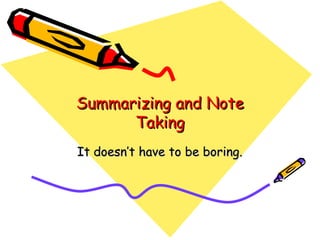
Summarizing And Note Taking
- 1. Summarizing and Note Taking It doesn’t have to be boring.
- 2. Objectives • You’ll develop your understandings around different genders and different learning styles. They require a variety of approaches • You’ll understand that note taking isn’t limited to rote copying • You’ll see that note taking is integrally related to reading for main ideas and writing to learn • You’ll learn a variety of note taking and summarizing techniques • You’ll apply your learning • I’ll show that I really can use a power point
- 3. Who is this guy? • 11 years of classroom teaching and instructional coaching • Law Degree from D.U. • M.A. in Curriculum & Instruction • Licensed and endorsed K-12 in English, Soc. Stu., & Reading • Co-Director of the Denver Writing Project • Cyclist, Dad, . . .
- 4. Let’s begin • Take a fortune cookie • Read your fortune to yourself • Don’t share it yet • Think: How does your fortune connect with teaching note taking in your classroom? • Share and then eat your cookie.
- 5. We need to read to take notes and before we read: We must have a purpose If we don’t have a purpose Everything is important And If everything is important Then nothing is important
- 6. The House (Thanks to Cris Tovani) • Count off in three’s • If you’re a ‘one’ read as a burglar – what’s important? • If you’re a ‘two’ read as a potential buyer – what’s important? • If you’re a ‘three’ read as a real estate agent – what’s important? • So – would your notes look different each time?
- 7. What about learning styles? • Think of these three basic learning styles: • Quantitative • Verbal • Non-Verbal • Will they learn the same way?
- 8. Strategies we’ll focus on today: • Power Notes: quantitative and verbal learners • Found Poetry: verbal learners • Visual Note Taking: non-verbal learners
- 9. Also, if we have time • Written Conversation • Q Notes • Somebody Wanted But So • Marzano’s 4 Steps
- 10. Power Notes a reading / writing strategy • Main ideas are P1 ideas • Elaborations or examples are P2 ideas • Further elaborations or examples are P3 ideas • Characteristics are P4 ideas
- 11. For Example • We might read an article about Football Penalties: • P1 – Football Penalties • P2 – Offensive Penalties • P3 – Holding, Face Mask, etc. • P4 – Characteristics of holding, etc.
- 12. If we use a graphic organizer P1 Fa n s o l ei ol a t Pe b l t P2 P2 Oveis fn P e fs n ee a i lt D i Pe e ve s f s ll eea n ti P3 P 3 P3 P3 H o lig dn I gee l ac r l l e eR i v Pn r c a tfe sen sr I ee H o lig dn P4 C ti c H h es o a r o lig r s f d a t c n
- 13. Let’s try it now • Read the science article • Try taking Power Notes on your own • Look for the P1 ideas, P2 ideas, etc. • Label them that way in your notes • Then. . .
- 14. • Use your notes as pre-writing to write a summary paragraph that shows your understanding.
- 15. Let’s be poets: • Read a Social Studies article • As you read, think about your purpose for reading and: • Highlight words and phrases that speak to you because they fulfill your purpose and also . . .
- 16. • They sound good • Are interesting or grab you • And are about the content (this is important) • List them or highlight them
- 17. • Now you’re a poet: • Look at your list and think of it as the words of a poem. • How can you structure them to look, sound and read like free verse poetry? • You can add words if you need to. • Only do that if it helps your poem make sense • The point is to show your content knowledge in a found poem. • Have fun
- 18. But first, an example: "CHICAGO” HOG Butcher for the World, Tool Maker, Stacker of Wheat, Player with Railroads and the Nation's Freight Handler; Stormy, husky, brawling, City of the Big Shoulders
- 19. For us visual learners Read the article on South Africa (if you want to stretch yourself, try the math article) Divide your paper in half, lengthwise Label the top left side: key words, phrases, ideas Label the right side: pictures Read the text stopping every 1/2 page
- 20. • On the left side, record important words, phrases, ideas • On the right side, draw your picture of what you read • When you’re finished, use your drawings to prompt your summary writing.
- 21. That’s it for now • How are you feeling? • What will you commit to try? • Who will you share it with
- 22. Oh Yeah, I forgot • Lee Waldman • lwaldman@jeffco.k12.co.us • 2-6257 • I have handouts for you that include other ideas
- 23. Resources • Beers, Kylene. When Kids Can’t Read. Portsmouth, NH: Heinemann, 2003. • Burke, Jim. Tools For Thought. Portsmouth, NH: Heinemann, 2002. • Marzano, Robert J,; Pickering, Debra J.; and Pollock, Jane E. Classroom Instruction that Works. Alexandria, VA: ASCD, 2001. • Tovani, Cris. I Read it But I Don’t Get It. Portland, ME: Stenhouse Publishers, 2000. • Tsujimoto, Joseph I. Teaching Poetry to Young Adolescents. Urbana, Ill: NCTE, 1988.